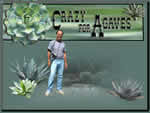|
Part two
A closer look at A. parryi var. huachucensis

picture 1
According J.Thiede (2001) the variety huachucensis refers to a plant from the high mountains of south east Arizona, north eastern Sonora and western Chihuahua. The name of this variety refers to the Huachuca Mountains in southern Arizona and the plant was originally described in 1888 as agave huachucensis by Baker. In 1953 this was replaced by A. parryi var. huachucensis (Baker) Little ex Benson.
Gentry was in agreement that A. huachucensis is a variety of A. parryi.
The differences noted were the larger leaves and the flowers with a broader “panicle”, the name panicle referring to a cluster of flowers
We found a nice picture on the cover of the magazine ’Agave’ from 1983. The picture was taken 6 miles south east of Sonoita on the way to Canelo at a height of 1500 metres. In 1961, in same area, George Olina [= Olin ??] took a picture of A. parryi var. huachucensis between Sonoita and Patagonia. This is in south east Tucson. We tried to find these plants in 2010, but the plants in that area are all cultivated plants now. Near Huachuca city we did find , in a park, some plants which were probably the real A. parryi var. huachuacensis (see picture 1 )
These plants tended to have darker leaves.
After finding beautiful forms of A. parryi in Mexico , 25 km west of Hidalgo del Parral and also in the Santa Clara Canyon, Sierra de la Campana, Chihuahua and between Tepehuanes and Santa Maria del Oro in Durango ( picture Josef Busek in the Kartei fromn Kakt. And. Sukk. 1991, 11 as nr. 32 as A. parryi var. parryi), Bernd. Ullrich had his doubts if the var. huachucensis was a valid separate entity.

Picture 2
In 2011 we did some research in Durango. We were at the site of A. parryi in the Sierra Chapultepec (picture 2 ), 100 kilometers along the Mex 45 from Gerez to Sombrerete

. picture 3
11 kilometres north of Durango, on Highway 36 from Santiago Papasquiaro and Topia, we found an area with an unbelievable number of plants. ( picture 3 and 4 )

picture 4
There are also many plants near Tepehuanes ( picture 5 ) with more and also with les leaves, between Tepehuanes and Santa Maria del Oro ( picture 6 ) and south of Hidalgo del Parral ( picture 7 ) . At all these sites the forms of A. parryi are more or less the same.

picture 5
In an article by Skinner (1961) in de C&S.J. (U.S.) we read that A. parryi var. huachucensis is different from A. parryi var. parryi and A. palmeri Engelm., this assertion based on studies in the southern U.S.A. In Skinner’s opinion the plants of A. parryi var. huachucensis have a different colour, ranging from beige-green to blue-green, with a brownish or black central spine. Also the bud printing on the leaves is visible from the time that the central leaves are growing. The leaves are broader and rounded near the central spine .
But most noticeable is the description of the plant form as a “tight cabbage’, emphasizing the round form of the plants.
In Skinner’s article of 1961 two pictures ( George Olina [= Olin ??] were published. Gentry’s picture appeared in the magazine Agave in the spring of 1983. You can see in the picture that the leaves are not as broad as there described in the article. All these pictures from plants we have seen show more or less similar plants. The internet is also another valuable resource.

picture 6
Our conclusion concerning the var. huachucensis is similar to Bernd Ullrich ,who was not convinced this was a separate entity. We would place the plant amongst the wide varying species that is A. parryi var. parryi.
That means that the distribution of A. parryi var. parryi is much bigger than formerly stated, starting in the south eastern U.S.A, near Tucson, and extending over the border deep into Mexico and reaching the state of Durango. Beyond Durango we come across the smaller forms going by the name var. truncata.

Picture 7
To be continued see part 3
Back to article overview
|




